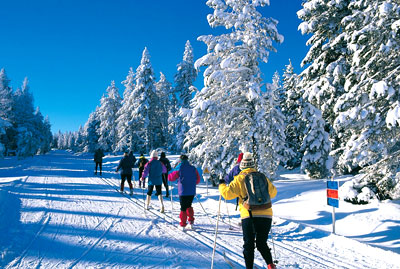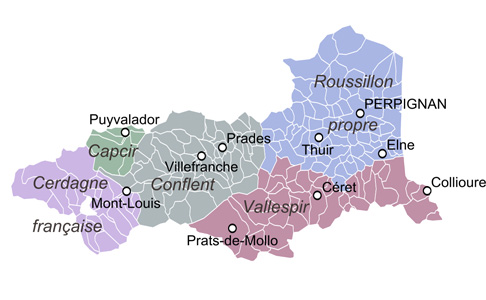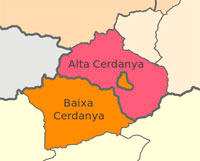VOL. 22 NO. 1

| March
2018 VOL. 22 NO. 1 |
 |
|
|
|
||
| The
Independent Traveler's Newsletter |
||
|
IN
THIS
ISSUE:
A Visit to Occitanie &
the Pyrénées - Part II
Twisted Tongues
~ Challenging French phrases Ici et Là
The Wines of the Pyrénées-Orientales THE BOOKSHELF: ~ Moments Parfaits in Paris a book by Sylvaine Lang A Hidden Gem in the French Countryside ~ First in a series  Cross Country Skiing in the Pyrénées-Orientales
Message
to Our Subscribers:
This newsletter has been a quarterly publication since 1997, but it has been decided to try something new. We will publish triannually going forward, so the 3 issues, beginning with this edition, will be published in March, July, and November. We hope you will continue to be a subscriber, enjoy the newsletter, and find the content useful for your next visit to FRANCE On Your Own. The next issue will be July 2018. |
|
This
newsletter is best viewed with a Firefox
browser with a full screen.
It is not
formatted
for printing.
" Every time I have some
moment on a seashore, or in the mountains, or sometimes in a
quiet
forest,
- Bill Bradley, American Athlete and Politician A Visit to Occitanie & the Pyrénées . . .Part II  Are you looking for unique places
on your next visit to France? Do you want to have the best of
nature at your fingertips ~ the Mediterranean, the mountains and
the opportunity to take in some wine country visits as well? Then
the Pyrénées-Orientales, bordering the
Pyrénées mountain range and Spain, is for you. Its capital, Perpignan ~ which in
the 13th century was the capital of the Kingdom of Majorca ~ displays a
strong Catalan influence found in the city's Medieval center. The
département oozes
history, offers the cuisine and culture of the Catalans, and is where
you will find the Via Domitia ~ the oldest Roman road in Gaul and one
of the oldest Roman roads anywhere. Over 1500 miles in length,
it links Rome to Cadiz, Spain, with its final French leg in the
Pyrénées-Orientales. Built in 188 BC by Gnaeus
Domitius Ahenobarbus [210 BC -162 BC], it was constructed about the
same
time as Narbonne in the Aude. Before the Treaty of the
Pyrénées in 1659, this département
was part of the old Principality of Catalonia under the
Crown of Aragon where the people spoke Catalan. The current département was formed
during the French Revolution in February of 1790 and named Roussillon
consistent with the pre-Revolutionary province of Roussillon; this
naming conflict required the need for a name change which took place
about two weeks later, and it become the
Pyrénées-Orientales. Today it is an area of 4115
square kilometers with a population of 422,000.
Cerdagne
is the westernmost area of the Pyrénées-Orientales, an it
is believed that early inhabitants spoke a form of old Basque. Later in its tumultuous history, it was
invaded by the Vandals and other Germanic tribes, it was part of the
Visigoth kingdom, and it was conquered by Muslims in the early
700s. It was in 785 that it came under Frankish rule when it was
conquered by Charlemagne after the surrender of Girona.
Today its only main towns are Puigcerdà on the Spanish side and Bourg-Madame on the French side. We crossed into Spain at Bourg-Madame many years ago when passports still had to be shown to the border agents. When
in the Cerdagne, you might want to take a ride on Le Petit Train Jaune
~ the Little Yellow Train,  Le Petit Train Jaune Le Petit Train JauneBill Bradley - American athlete and politician
A Visit to
Occitanie & the Pyrénées ~ Part II ~ the
Pyrénées-Orientales
Are you
looking for unique places on your next visit to
France? Do you want to have the best of nature at your fingertips
~ the Mediterranean, the mountains and the opportunity to
take in some wine country visits as well? Then the fourth département of Occitanie in our series, the Pyrénées-Orientales ~ bordering the
Pyrénées mountain range and Spain ~ is for you.
Its capital, Perpignan, the capital of the Kingdom of Majorca in the 13th century, displays a strong Catalan influence found in the city's Medieval center. This département oozes history, offers the cuisine and culture of the Catalans, and is where you will find the Via Domitia ~ the oldest Roman road in Gaul and one of the oldest Roman roads anywhere. Over 70,000 miles in length, it links Rome to Cadiz, Spain, with its final French leg in the Pyrénées-Orientales. Built in 118 BC by Gnaeus Domitius Ahenobarbus, it was constructed about the same time as today's Narbonne in the Aude département, known then as Colonia Narbo Martius. Before the Treaty of the
Pyrénées in 1659 this département
was part of the old Principality of Catalonia under the Crown of Aragon
where the people spoke Catalan. The current département was formed
during the French Revolution in February of 1790 and named Roussillon, consistent with the
pre-Revolutionary province of Roussillon; this naming conflict required
the need for a name
change about
two weeks later to Pyrénées-Orientales.
Today it is an area of 4115 square kilometers with a population of
422,000.
 The region of Cerdagne (France) or Cerdanya (Spanish), is equally divided between France and Spain [see map left]. The red portion is in France, and the small orange area within it is Llívia as is the white patch in the map above ~ more about that follows. Cerdagne is the westernmost area of the Pyrénées-Orientales, and it is believed that early inhabitants spoke a form of old Basque. Later in its tumultuous history, it was invaded by the Vandals and other Germanic peoples, it was part of the Visigoth kingdom, and eventually was conquered by the Muslims in the early 700s. It was in 785 that it came under Frankish rule when it was conquered by Charlemagne after the surrender of Girona. Today its only main towns are Puigcerdà on the Spanish side and Bourg-Madame on the French side. We crossed into Spain at Bourg-Madame many years ago when passports still had to be shown to the border agents.  When in the
Cerdagne you might want to take a ride on Le Petit Train Jaune,
the Little
Yellow Train,
also known as the Ligne de Cerdagne, whose construction began in 1903. Its route is 69 kilometers (43 miles) long and the train climbs to 5,226 feet ~ to the highest railway station in France. It crosses two bridges and goes through nineteen tunnels on a single track, so there are a few 'passing loops'. Power generators on the River Tet keep this electric train in motion. You will notice it is not just yellow but has some red coloring as well ~ homage to the Catalan flag. Some of the cars are open in good weather, and because local roads were improved over the years, it has become more of a tourist attraction than necessary transportation for locals. You may want to begin your yellow train journey at Villefranche-le-Conflent the starting point in the eastern Pyrénées 50 kms inland from Perpignan and designated one of the Most Beautiful Villages of France.
continued on page three
|
||
LOOK INSIDE . . . with a click > and perhaps find an event or activity that interests you in the US or France in our Ici et Là column ~ and be sure to see our newest Ici et Là feature: Did You Know? ~
> to read
about Llívia,
the tiny hamlet of Llo, and the enchanting guest house, L'Atalaya, a bit of its
history and our personal experience in this
unique place in France.~
>
to complete our visit to Occitanie along the rugged
Pyrénées mountain range, join us for a tour of the département of
the Pyrénées-Orientales, bordering
both the Pyrénées and the
Mediterranean. ~
> for a peek into Moments Parfaits in
Paris, an insightful, easy read about Sylvaine Lang's
special
moments and memories of her times in Paris ~ a series of short
vignettes accompanied by her own creative photography.
FRANCE On
Your Own invites articles
from our readers about their time in France. We can't guarantee when we will publish all those we receive, but we will do our best to include them for our other readers to enjoy. [No payments are made for submissions used, but we will promote your France-related book or project.] |
|
TWISTED
TONGUES . . . contributed by Arthur Gillette Welcome to Twisted Tongues, a French word game everyone can play. Can you come up with the correct translation of the phrase in question? You'll be surprised by how it differs from what you first thought it meant. Answer
from our Autumn issue: "A la vache!" does not mean
"Oh, the cow!". The slang meaning
is "I'll be darned! " or "Shucks!" Phrase: "Chanter en yaourt" Does it mean
"Singing in yogurt?" No. What do you think the slang meaning is? Look for the correct translation in our July 2018 newsletter. Have fun! We
will continue to include Arthur
Gillette's "Twisted Tongues" in our newsletter
SPONSORING
THIS ISSUE
bed and breakfast (except in July and August) with a beautiful swimming pool and easy access to many of the region's most interesting attractions. This immaculate property offers hypoallergenic bedding, geothermal heating and the peace and tranquility of its 100-acre estate. Consider scheduling your stay to take advantage of one of the garden tours described on their web pages. It's a few minutes away from the bastide market town of Monpazier, very near the enormous Château de Biron open to the public for visits, and a short drive from Sarlat-le-Caneda the capital of the Périgord-Noir. Those who love the outdoors will enjoy canoeing on the Dordogne River or following the path of the meandering River Lot. This is an exceptional property in the perfect location, so click on the link or photo above to read all about it and to see the beautiful rooms and gardens. Click here or
on the photo for more information and reservations.  ©1997-2018 Cold Spring Press All Rights Reserved Recommendations are not guarantees of satisfaction and are made only to assist travelers with suggestions and web sites that we have found very useful. |
||